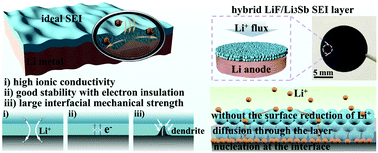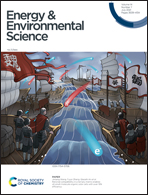An artificial hybrid interphase for an ultrahigh-rate and practical lithium metal anode†
Abstract
The solid electrolyte interphase (SEI) layer is pivotal for stable lithium (Li) metal batteries especially under a high rate. However, the mechanism of Li+ transport through the SEI has not been clearly elucidated to build robust Li anodes for practical Li metal batteries. Herein, an artificial hybrid SEI layer consisting of lithium-antimony (Li3Sb) alloy and lithium fluoride (LiF) is constructed to explore the ion diffusion behaviors within the SEI. As evidenced theoretically and experimentally, Li3Sb is identified as a superionic conductor for Li+ transport and as an interfacial stabilizer for the SEI layer while the LiF component with superior electron-blocking capability reduces the electron tunneling from the Li anode into the SEI, resulting in uniform dendrite-free Li deposition at the SEI/Li interface and stable Li plating/stripping behaviors at an ultrahigh rate of 20 mA cm−2. A practical 325.28 W h kg−1 pouch cell is well demonstrated under a high sulfur loading of 6 mg cm−2 and a low electrolyte/sulfur ratio of 3 μl mg−1. This work uncovers the internal mechanism of Li+ transport within the SEI component, and provides an avenue to stabilize the Li anode under practical high-rate conditions.



 Please wait while we load your content...
Please wait while we load your content...